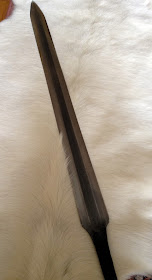Sliþrung Part 1
 Crucial to future appreciation of the Staffordshire Hoard, and recognition of the historical golden age (rather than ‘Dark Age’) it represents, is the effective communication of it’s story and insights to members of the public.
Crucial to future appreciation of the Staffordshire Hoard, and recognition of the historical golden age (rather than ‘Dark Age’) it represents, is the effective communication of it’s story and insights to members of the public.
Although found out of any useful immediate context, hoard finds do each have a story to tell; some are connected with neighbouring items in the hoard, while others are linked to other finds elsewhere in England and beyond, hinting at trade and cultural ties.
Inspired by the tree of connections rooted by the Staffordshire Hoard, I embarked on a project to produce a single assembly capable of providing visual context to a number of hoard finds, and illustrate the hoard’s broader context both in time, and in relation to neighbouring kingdoms and cultures.
My first sight of what would later be known as Sliþrung was on Christmas day 2011 while opening a fairly weightless tubular parcel that I was convinced contained a poster; a gift for which I remain eternally grateful. Inside lay a beautiful pattern-welded sword blade created by master blacksmith Paul Binns.
 |
| Two-twist patternwelded blade by Paul Bins |
Adorned by a beautifully elegant two-twist pattern along a shallow fuller, the blade was found to be incredibly flat and sharp, and thus increadibly light, yet flexible and strong.
 |
| Tip of the blade |
The contrast to the blade of my father’s sword, Notung, could hardly be more striking. While Notung is fairly thick in profile (due to the magnificent and unique 'serpent in the sword' pattern), the new blade is much thinner, feeling almost weightless in comparison. Although the mighty Notung’s blade measures 31.5 inches, around the average length of an Anglo-Saxon sword, my new blade is somewhat shorter, measuring 27.5 inches.
Combined, the difference these factors make is significant. While Anglo-Saxon swords, particularly those of the early period (with shallow or no fuller) tend to be very-tip heavy, the shorter length of the new blade and it’s slender profile both contribute to it being excellently balanced.
The length and balance of this sword cannot be considered representative of those of the period; compared to those in the archaeological record, this blade is too short. With reduced reach, the wielder of such a weapon might find himself at a disadvantage. However, it should be noted that such a blade has greater reach than most examples of the more common side-arm; the seax. The wielder of this weapon would therefore still have something of an advantage over the average warrior.
 Though not ideal from a historical perspective, the reduced length of the blade in question does bring modern practical advantages. Wearing a full length sword can be something of an encumbrance or a hazard if you are of shorter stature, particularly at more cramped living history events. Furthermore, it was because of the reduced length (and Paul’s generosity) that the blade was affordable, and I do not think it detracts from the magnificence of the metal work. Although short, the blade's edges remain parallel until very near the tip, therefore having a shape that is consistent with early Anglo-Saxon sword finds.
Though not ideal from a historical perspective, the reduced length of the blade in question does bring modern practical advantages. Wearing a full length sword can be something of an encumbrance or a hazard if you are of shorter stature, particularly at more cramped living history events. Furthermore, it was because of the reduced length (and Paul’s generosity) that the blade was affordable, and I do not think it detracts from the magnificence of the metal work. Although short, the blade's edges remain parallel until very near the tip, therefore having a shape that is consistent with early Anglo-Saxon sword finds.
We quickly set about planning the assembly of the hilt and sheath. During the following months we eagerly awaited a number of commissions from George Easton of Danegeld.
Meanwhile, at the first opportunity during March and April, I began work on the sheath. It may seem rather backwards to assemble a sheath before the hilt is done, but I was keen to have the sharp blade lying around unprotected for as little time as possible. Having a blade as sharp as this simply lying around unsheathed is rather unsafe.
Like the sheath of Notung, I decided the it should be constructed with a wooden core. Two planks of thin pine were acquired, and thin square-cut strips were glued onto one, around a sketch of the blade. Learning from past experiences, we left two inches or so at the end of the sheath that, not containing the blade, would be able to accommodate attachments for the protective chape.
 |
| Wooden core of the sheath, compared to the blade |
 |
The valley created was further hollowed out by sanding, and strips of lambskin, closely shorn (making sure not to take off so much that the sheath would be loose), were then glued into place inside the slot, and onto the corresponding area on the other plank. This was then glued on top. Following drying, the outside was filed and sanded down.
Nb. With this method, it was not necessary to cushion the bottom of the sheath, as the tip of the sword would never reach it. If a sheath is sufficiently long, the lower guard should hit the throat before the tip gets near the end. For this reason, constructing the sheath lining like a sock is not necessary.
With the structure of the sheath complete, the new blade was safe from damage, as was the family dog. We were then able to move on to work on the sword’s hilt.

